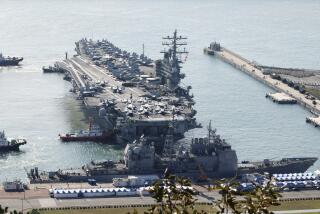New U.S. Military Strategy Worries Seoul : South Korea: Official arrives in Washington to convey anxieties about emerging policy of fighting one war at a time.
- Share via
WASHINGTON — South Korea is preparing to voice high-level concern to the Clinton Administration about an emerging new American military strategy in which the United States, largely for budgetary reasons, would stand prepared to fight only one major war at a time, South Korean officials said Friday.
Chung Chong Uk, national security adviser to South Korean President Kim Young Sam, arrived in Washington on Friday and plans to convey Seoul’s anxieties in meetings over the next few days with senior officials at the National Security Council, the State and Defense departments and the CIA.
Chung is expected to meet with National Security Adviser Anthony Lake, Undersecretary of State Peter Tarnoff and Assistant Secretary of State Winston Lord, among other officials.
Seoul’s jitters about the evolving Pentagon strategy illustrate the extent to which American allies are afraid that the United States may be forced by budget cutbacks to retreat to a less active role around the world.
Some diplomats here say that their governments have been unsettled by the coincidence of two recent developments in Washington. One was the speech last month in which a senior State Department official, later identified as Tarnoff, said that “we don’t have the money” to act as freely around the world as the United States has done in the past. The second is the new war-fighting strategy being developed by Defense Secretary Les Aspin.
Under the proposed strategy, the United States would abandon its doctrine of maintaining enough forces to fight wars in two places around the world at the same time. Instead, the Pentagon would keep only enough troops and equipment to win one conflict while, at the same time, holding the line in a second war until the first was over.
Supporters of the new strategy have dubbed it “win-hold-win”-- that is, to win one war, hold off the enemy in a second conflict and then finally defeat the second enemy.
But South Korean officials say they worry that, under such a strategy, their nation might easily be the “hold”--that is, the country that would be asked to wait for days or weeks, in a military stalemate, while the United States finished a conflict elsewhere.
South Korean Ambassador to Washington Han Seung Soo told The Times on Friday that his government is particularly worried that North Korea might “misinterpret” the new, scaled-back U.S. military strategy as a sign of American weakness.
Clinton is scheduled to visit South Korea for two days next month as part of his first overseas trip as President. While there, he will meet President Kim, deliver a speech to Korea’s National Assembly and visit the demilitarized zone between South and North Korea.
South Korean and other Asian diplomats have said that they hope the President will seize the opportunity to reaffirm the U.S. commitment to maintain its troop presence and its role in a balance of power in Asia. There are now about 37,000 American troops in South Korea.
Over the last several years, American and South Korean officials have grown increasingly concerned by North Korea’s efforts to develop nuclear weapons. In March, under intense pressure to open up its nuclear facilities to international inspections, North Korea suddenly threatened to withdraw from the Nuclear Non-Proliferation Treaty, the agreement that bars the spread of nuclear weapons.
This month, after senior U.S. and North Korean officials met in New York, North Korea announced that it would hold off on its threat to withdraw from the treaty. But it has not yet said whether it will open up its nuclear facilities to international inspections.
More to Read
Sign up for Essential California
The most important California stories and recommendations in your inbox every morning.
You may occasionally receive promotional content from the Los Angeles Times.













